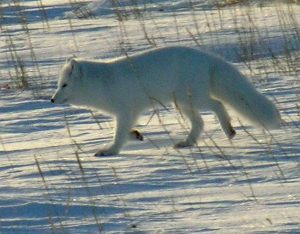1.1 – What is Physiology?
Introduction - What is physiology?
The content of this chapter was adapted from the Concepts of Biology-1st Canadian Edition open textbook by Charles Molnar and Jane Gair (Chapter 11 – Introduction to the body’s systems).
 |
1.1. Define physiology and explain its importance and connections to other fields of biological studies. |
Physiology is a study of how animal form or structure and function sustain life and shape responses to environmental conditions. The arctic fox (Figure 1.1), a complex animal that has adapted to its environment, illustrates the relationships between an animal’s form and function. The multicellular bodies of animals consist of tissues that make up more complex organs and organ systems. The organ systems of an animal maintain homeostasis within the multicellular body. These systems are adapted to obtain the necessary nutrients and other resources needed by the cells of the body, to remove the wastes those cells produce, to coordinate the activities of the cells, tissues, and organs throughout the body, and to coordinate the many responses of the individual organism to its environment.

 |
Some examples of arctic fox physiological adaptions to its environment include:
SOURCE: PESTRUD, P. (1991). Adaptations by the Arctic Fox (Alopex lagopus) to the Polar Winter. Arctic, 44(2), 132-138. Retrieved 2018 February 5 from http://www.jstor.org/stable/40511073. |
The study of physiology is interrelated with other fields of biological studies, such as
- Anatomy (how organisms are structured),
- Biogeography (spatial and temporal distribution of organisms),
- Biomechanics (the study of how organisms move),
- Conservation Biology (the study of the natural environment and ecosystems),
- Ecology (the study of how organisms interact with other living organisms and their environment),
- Ethology (the study of animal behaviour), and
- Other fields of Biology.
 |
Question 1.1
Define physiology in your own words. |
 |
Watch this PBS Nature video to see how foxes find prey in the winter. |
(Adaptations) -
Characteristics of an organisms that are oftentimes inherited in order to optimize survival and reproductive success to their relative environment. (Reece et al, 2018).
Refers to the steady physiological state conditions of an organism’s body (Reece et al, 2018).

